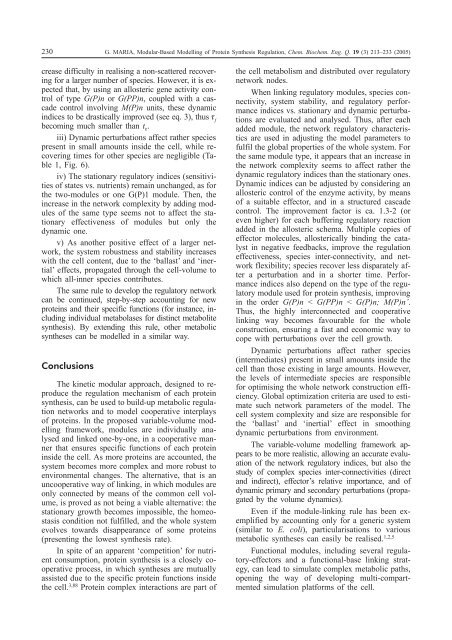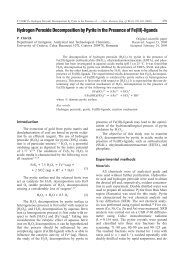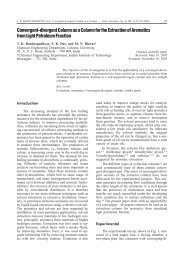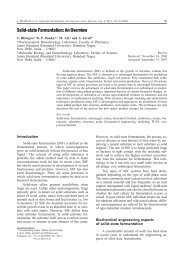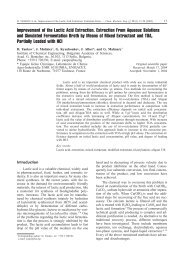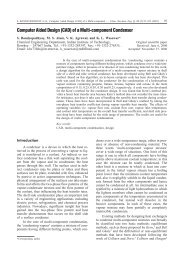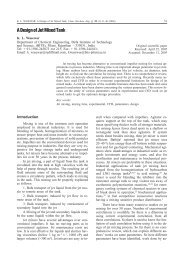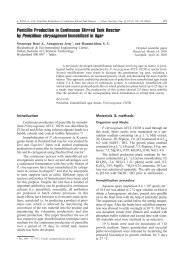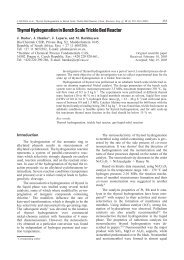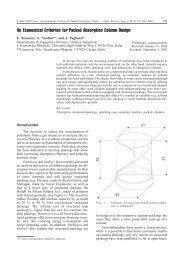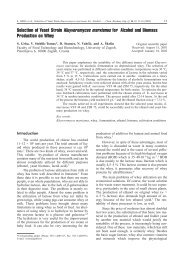Modular-Based Modelling of Protein Synthesis Regulation
Modular-Based Modelling of Protein Synthesis Regulation
Modular-Based Modelling of Protein Synthesis Regulation
Create successful ePaper yourself
Turn your PDF publications into a flip-book with our unique Google optimized e-Paper software.
230 G. MARIA, <strong>Modular</strong>-<strong>Based</strong> <strong>Modelling</strong> <strong>of</strong> <strong>Protein</strong> <strong>Synthesis</strong> <strong>Regulation</strong>, Chem. Biochem. Eng. Q. 19 (3) 213–233 (2005)<br />
crease difficulty in realising a non-scattered recovering<br />
for a larger number <strong>of</strong> species. However, it is expected<br />
that, by using an allosteric gene activity control<br />
<strong>of</strong> type G(P)n or G(PP)n, coupled with a cascade<br />
control involving M(P)n units, these dynamic<br />
indices to be drastically improved (see eq. 3), thus j<br />
becoming much smaller than t c .<br />
iii) Dynamic perturbations affect rather species<br />
present in small amounts inside the cell, while recovering<br />
times for other species are negligible (Table<br />
1, Fig. 6).<br />
iv) The stationary regulatory indices (sensitivities<br />
<strong>of</strong> states vs. nutrients) remain unchanged, as for<br />
the two-modules or one G(P)1 module. Then, the<br />
increase in the network complexity by adding modules<br />
<strong>of</strong> the same type seems not to affect the stationary<br />
effectiveness <strong>of</strong> modules but only the<br />
dynamic one.<br />
v) As another positive effect <strong>of</strong> a larger network,<br />
the system robustness and stability increases<br />
with the cell content, due to the ‘ballast’ and ‘inertial’<br />
effects, propagated through the cell-volume to<br />
which all-inner species contributes.<br />
The same rule to develop the regulatory network<br />
can be continued, step-by-step accounting for new<br />
proteins and their specific functions (for instance, including<br />
individual metabolases for distinct metabolite<br />
synthesis). By extending this rule, other metabolic<br />
syntheses can be modelled in a similar way.<br />
Conclusions<br />
The kinetic modular approach, designed to reproduce<br />
the regulation mechanism <strong>of</strong> each protein<br />
synthesis, can be used to build-up metabolic regulation<br />
networks and to model cooperative interplays<br />
<strong>of</strong> proteins. In the proposed variable-volume modelling<br />
framework, modules are individually analysed<br />
and linked one-by-one, in a cooperative manner<br />
that ensures specific functions <strong>of</strong> each protein<br />
inside the cell. As more proteins are accounted, the<br />
system becomes more complex and more robust to<br />
environmental changes. The alternative, that is an<br />
uncooperative way <strong>of</strong> linking, in which modules are<br />
only connected by means <strong>of</strong> the common cell volume,<br />
is proved as not being a viable alternative: the<br />
stationary growth becomes impossible, the homeostasis<br />
condition not fulfilled, and the whole system<br />
evolves towards disappearance <strong>of</strong> some proteins<br />
(presenting the lowest synthesis rate).<br />
In spite <strong>of</strong> an apparent ‘competition’ for nutrient<br />
consumption, protein synthesis is a closely cooperative<br />
process, in which syntheses are mutually<br />
assisted due to the specific protein functions inside<br />
the cell. 3,88 <strong>Protein</strong> complex interactions are part <strong>of</strong><br />
the cell metabolism and distributed over regulatory<br />
network nodes.<br />
When linking regulatory modules, species connectivity,<br />
system stability, and regulatory performance<br />
indices vs. stationary and dynamic perturbations<br />
are evaluated and analysed. Thus, after each<br />
added module, the network regulatory characteristics<br />
are used in adjusting the model parameters to<br />
fulfil the global properties <strong>of</strong> the whole system. For<br />
the same module type, it appears that an increase in<br />
the network complexity seems to affect rather the<br />
dynamic regulatory indices than the stationary ones.<br />
Dynamic indices can be adjusted by considering an<br />
allosteric control <strong>of</strong> the enzyme activity, by means<br />
<strong>of</strong> a suitable effector, and in a structured cascade<br />
control. The improvement factor is ca. 1.3-2 (or<br />
even higher) for each buffering regulatory reaction<br />
added in the allosteric schema. Multiple copies <strong>of</strong><br />
effector molecules, allosterically binding the catalyst<br />
in negative feedbacks, improve the regulation<br />
effectiveness, species inter-connectivity, and network<br />
flexibility; species recover less disparately after<br />
a perturbation and in a shorter time. Performance<br />
indices also depend on the type <strong>of</strong> the regulatory<br />
module used for protein synthesis, improving<br />
in the order G(P)n < G(PP)n < G(P)n; M(P)n’.<br />
Thus, the highly interconnected and cooperative<br />
linking way becomes favourable for the whole<br />
construction, ensuring a fast and economic way to<br />
cope with perturbations over the cell growth.<br />
Dynamic perturbations affect rather species<br />
(intermediates) present in small amounts inside the<br />
cell than those existing in large amounts. However,<br />
the levels <strong>of</strong> intermediate species are responsible<br />
for optimising the whole network construction efficiency.<br />
Global optimization criteria are used to estimate<br />
such network parameters <strong>of</strong> the model. The<br />
cell system complexity and size are responsible for<br />
the ‘ballast’ and ‘inertial’ effect in smoothing<br />
dynamic perturbations from environment.<br />
The variable-volume modelling framework appears<br />
to be more realistic, allowing an accurate evaluation<br />
<strong>of</strong> the network regulatory indices, but also the<br />
study <strong>of</strong> complex species inter-connectivities (direct<br />
and indirect), effector’s relative importance, and <strong>of</strong><br />
dynamic primary and secondary perturbations (propagated<br />
by the volume dynamics).<br />
Even if the module-linking rule has been exemplified<br />
by accounting only for a generic system<br />
(similar to E. coli), particularisations to various<br />
metabolic syntheses can easily be realised. 1,2,5<br />
Functional modules, including several regulatory-effectors<br />
and a functional-base linking strategy,<br />
can lead to simulate complex metabolic paths,<br />
opening the way <strong>of</strong> developing multi-compartmented<br />
simulation platforms <strong>of</strong> the cell.


